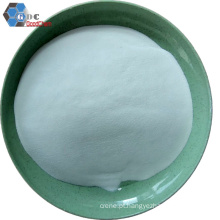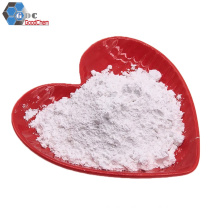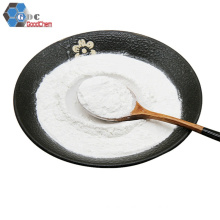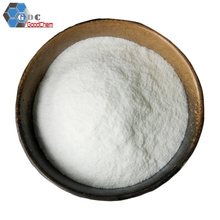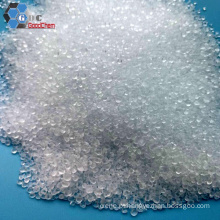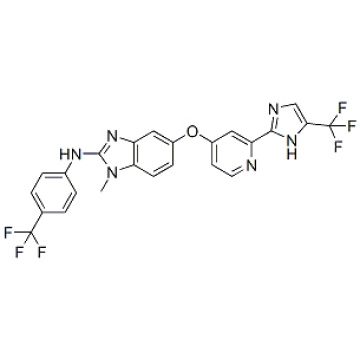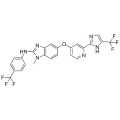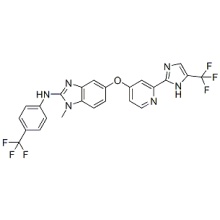.cp_wz table {border-top: 1px solid #ccc; border-left: 1px solid #ccc; } .cp_wz table td {border-right: 1px solid #ccc; borda inferior: 1px sólido #ccc; preenchimento: 5px 0px 0px 5px;} .cp_wz tabela th {border-right: 1px solid #ccc; border-bottom: 1px solid #ccc; padding: 5px 0px 0px 5px;} \ n Peso Molecular: \ n 518,41 RAF265 (CHIR-265) é um inibidor potente e selectivo de C-Raf / B-Raf / B-Raf V600E com IC50 de 3-60 nM, e exposições inibição potente sobre a fosforilação de VEGFR2 com EC50 de 30 nM. Fase 2. \ n Actividade Biológica RAF265 inibe C-Raf, o tipo selvagem de B-Raf e mutante (V600E) B-Raf. RAF265 eficazmente bloquear a fosforilao de substratos a jusante de Raf MEK e ERK em células e também matar melanoma e culas de cancro colo-rectal linhas albergando mutaes de B-Raf independentes do estado de mutação de PTEN. Inibição da quinase Raf por RAF265 em linhas de células de melanoma B-Raf mutante provoca a paragem do ciclo celular e induz a apoptose, imitando o efeito de RNAi Raf nestas células. RAF265 também inibe potencialmente a fosforilação de VEGFR2 e proliferação de HMVEC-VEGF estimulada. Em HT29 e células MDAMB231, actividade inibidora mostra RAF265 com IC20 de 1 a 3 uM e IC50 de 5 a 10 uM, respectivamente. Enquanto conduz RAF265 a uma diminuição significativa na sobrevivência clonogénica em todas as linhas celulares testadas, o que significa que RAF265 induz um efeito dominante sobre a sobrevivência clonogénica. A adição de RAF265 para RAD001 em HCT116 células poderia levar a moderada diminuição de AKT, proteína S6, e 4EBP1 fosforilação. RAF265 reduz marcadamente o nível de proteína Bcl-2 e inibidores grande em CM- e as células NCI-H727, embora não tendo efeito sobre a sensibilidade de TRAIL de células BON1 e GOT1. Proteína quinase D3 (PRKD3) que, quando derrubado poderia aumentar a morte celular por RAF265 em A2058 células de melanoma, o que evita a reactivação de sinalizao de MAPK, induzir a clivagem de PARP, a actividade da caspase aumento, progressão do ciclo celular de interrupção, e a formação de inibição de colónia. mostra RAF265 71% a 72% TVI% (percentagem de inibição do volume do tumor) em xenoenxertos HCT-116 a 12 mg / kg. Embora a combinação de espectáculos RAF265 e RAD001 reforçada antitumoral actividade com o aumento do T10 (tempo para atingir um volume de tumor relativo de 10 vezes o volume inicial do tumor) e atraso do crescimento do tumor. A combinação de RAD001 e RAF265 também aumenta significativamente a activação de caspase-3 em HCT116 e MDAMB231 mas não em xenoenxertos A549. RAF265 inibe FDG (2-desoxi-2- fluoro-d-glicose [18F]) acumulação e diminui os volumes dos tumores em xenoenxertos A375M por administrados por via oral de 100 mg / kg. Ensaio de cinase de protocolo (apenas para referência): [1]
|
Assay Protocol
|
Raf and Mek are combined at 2 × final concentrations in assay buffer (50 mM Tris, pH 7.5, 15 mM MgCl2. 0.1 mM EDTA and 1 mM DTT) and dispensed 15 μL per well in polypropylene assay plates. Background levels are determined in wells containing Mek and DMSO without Raf. To the Raf/Mek containing wells is added 3 μL of 10 × of RAF265 diluted in 100% DMSO. The raf kinase activity reaction is started by the addition of 12 μL per well of 2.5 × 33P-ATP diluted in assay buffer. After 45-60 minutes, the reactions are stopped with the addition of 70 μL of stop reagent (30 mM EDTA). Filtration plates are pre-wetted for 5 min with 70% ethanol, and then rinsed by filtration with wash buffer. Samples (90 μL) from the reaction wells are then transferred to the filtration plates. The filtration plates are washed 6 × with wash buffer using Millipore filtration apparatus. The plates are dried and 100 μL per well of scintillation fluid is added. The CPM is then determined using a Wallac Microbeta 1450 reader.
|
|
In Vitro Raf Screen
|
The activity of various isoforms of Raf serine/threonine kinases can be measured by providing ATP, MEK substrate, and assaying the transfer of phosphate moiety to the MEK residue. Recombinant isoforms of Raf are obtained by purification from sf9 insect ce
|
Ensaio de células: [2]
|
Cell lines
|
Human A549 and H460 lung, HT29 and HCT 116 colon, and MDAMB231 breast cancer cell lines
|
|
Concentrations
|
0.1 - 10 μM
|
|
Incubation Time
|
48 hours
|
|
Method
|
The MTT assay and Bliss additivism model are used to assess the effect of RAF265 on cell viability. In each well of a 96-well plate, 1 × 104 cells are grown in 200 μL of medium. After 24 hours, RAF265 is added to achieve a final concentration of 0.1 to 10 μM. After 48 hours of treatment, 20 μL of 5 mg/mL MTT solution in PBS is added to each well. After 4 hours, supernatant is removed and formazan crystals are discarded in 200 μL of DMSO. Absorbance is then measured at 595 nm using an absorbance plate reader. Data are expressed as the percentage of viable cells.
|
Estudo Animal: [2]
|
Animal Models
|
A549, H460, HCT116, or MDAMB231 cells are injected s.c. into the flank region of 6-wk-old female athymic mice.
|
|
Formulation
|
Dissolved in polyethylene glycol-400 (PEG-400) to a concentration of 25 mg/mL. [5]
|
|
Dosages
|
12 mg/kg
|
|
Administration
|
Orally administered daily
|
|
Solubility
|
30% PEG400/0.5% Tween80/5% propylene glycol,
30 mg/mL
|
|
* Please note that Selleck tests the solubility of all compounds in-house, and the actual solubility may differ slightly from published values. This is normal and is due to slight batch-to-batch variations.
|
Conversão de diferentes modelos de animais com base em BSA (valor com base em dados das diretrizes preliminares da FDA)
|
Species
|
Baboon
|
Dog
|
Monkey
|
Rabbit
|
Guinea pig
|
Rat
|
Hamster
|
Mouse
|
|
Weight (kg)
|
12
|
10
|
3
|
1.8
|
0.4
|
0.15
|
0.08
|
0.02
|
|
Body Surface Area (m2)
|
0.6
|
0.5
|
0.24
|
0.15
|
0.05
|
0.025
|
0.02
|
0.007
|
|
Km factor
|
20
|
20
|
12
|
12
|
8
|
6
|
5
|
3
|
|
Animal A (mg/kg) = Animal B (mg/kg) multiplied by
|
Animal B Km
|
|
Animal A Km
|
Por exemplo, para modificar a dose de resveratrol usada para um camundongo (22,4 mg / kg) para uma dose baseada na BSA para um rato, multiplique 22,4 mg / kg pelo fator Km para um camundongo e, em seguida, divida pelo fator Km para um rato. Este cálculo resulta em uma dose equivalente de rato para o resveratrol de 11,2 mg / kg.
|
Rat dose (mg/kg) = mouse dose (22.4 mg/kg) ×
|
mouse Km(3)
|
= 11.2 mg/kg
|
|
rat Km(6)
|
Informação Química
|
Molecular Weight (MW)
|
518.41
|
|
Formula
|
C24H16F6N6O
|
|
CAS No.
|
927880-90-8
|
|
Storage
|
3 years -20℃Powder
|
|
6 months-80℃in solvent (DMSO, water, etc.)
|
|
Synonyms
|
|
|
Solubility (25°C) *
|
In vitro
|
DMSO
|
100 mg/mL
(192.89 mM)
|
|
Water
|
<1 mg/mL
(
|
|
Ethanol
|
33 mg/mL
(63.65 mM)
|
|
In vivo
|
30% PEG400/0.5% Tween80/5% propylene glycol
|
30 mg/mL
|
* <1 mg/ml means slightly soluble or insoluble.
* Please note that Selleck tests the solubility of all compounds in-house, and the actual solubility may differ slightly from published values. This is normal and is due to slight batch-to-batch variations.
|
|
Chemical Name
|
1-methyl-5-(2-(5-(trifluoromethyl)-1H-imidazol-2-yl)pyridin-4-yloxy)-N-(4-(trifluoromethyl)phenyl)-1H-benzo[d]imidazol-2-amine
|
Calculadora de molaridade Calculadora de diluição Calculadora de peso molecular
Grupo de Produto : MAPK > Inibidor de Raf
